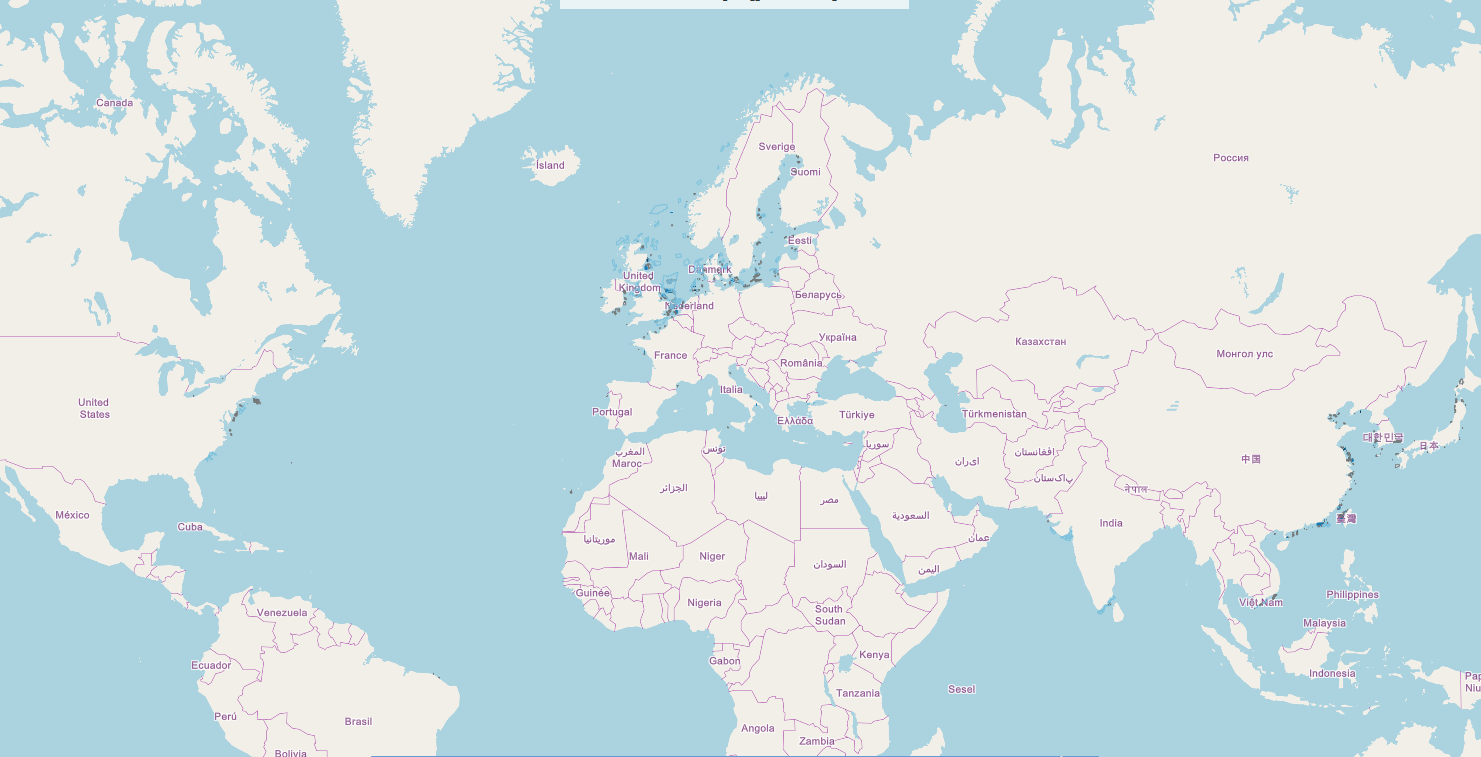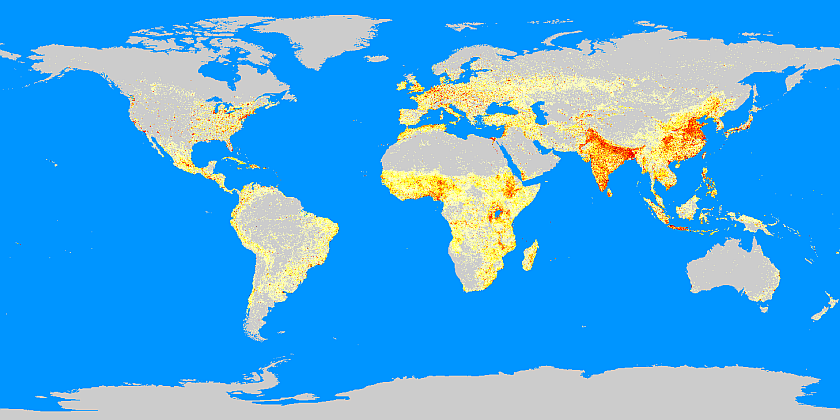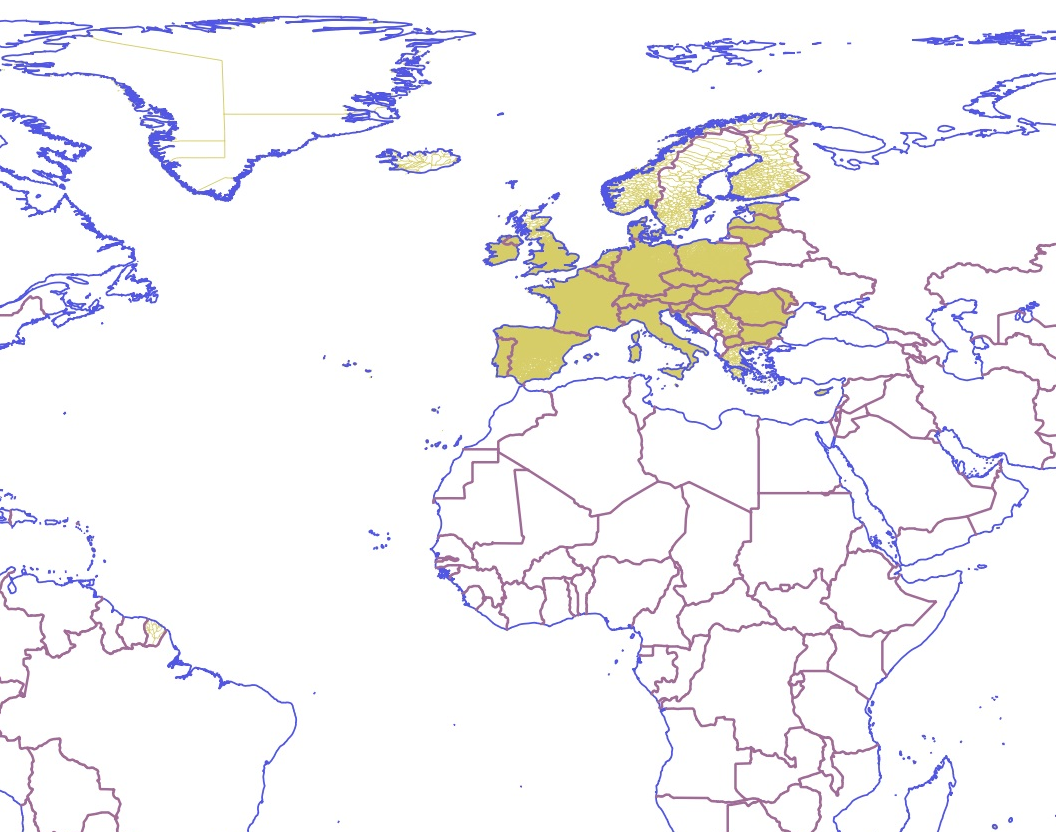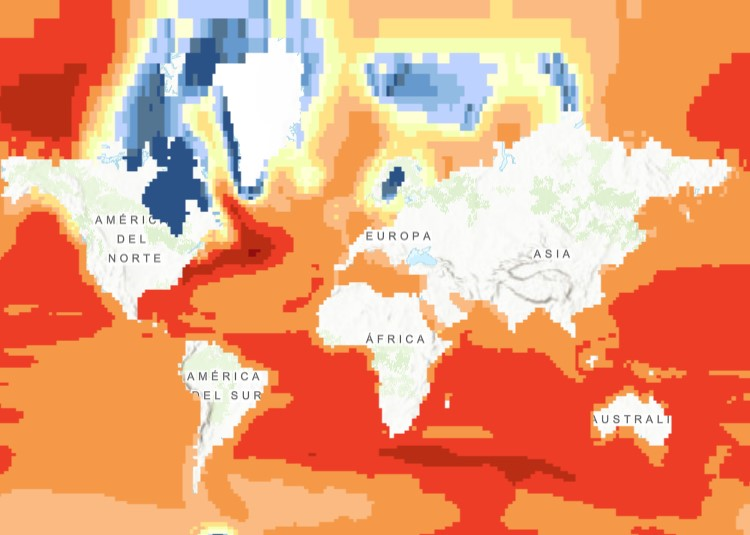World
Type of resources
Available actions
Topics
INSPIRE themes
Keywords
Contact for the resource
Provided by
Years
Formats
Representation types
Update frequencies
status
Scale
Resolution
-

This data set contains the administrative boundaries at country level of the world and is based on the geometry from EBM v12.x. of EuroGeographics for the members of Eurogeographics, the Global Administrative Units Layer (2015) from FAO (UN) and geometry from the Turkish National Statistical Office. This dataset consists of 2 feature classes (regions, boundaries) per scale level and there are 6 different scale levels (100K, 1M, 3M, 10M, 20M and 60M). The public dataset is available at 1M, 3M, 10M, 20M, 60M, while the full dataset at 100K is restricted. This metadata only refers to the full dataset (polygon) at 100k (CNTR_RG_100K_2016 in the GISCO database) and shall only be used internally by the EEA. This metadata has been slightly adapted from the original metadata file provided by Eurostat (European Commission) and is to be used only for internal EEA purposes. For reference, the original metadata file provided by ESTAT (CNTR_2016.xml) is provided together with the dataset. The public dataset is available for download on http://ec.europa.eu/eurostat/cache/GISCO/distribution/v2/countries/countries-2016-files.html
-

This data set contains the administrative boundaries at country level of the world and is based on the geometry from EBM v8.x. of EuroGeographics for the members of Eurogeographics, the Global Administrative Units Layer (2013) from FAO (UN) and geometry from the Turkish National Statistical Office. This dataset consists of 2 feature classes (regions, boundaries) per scale level and there are 6 different scale levels (100K, 1M, 3M, 10M, 20M and 60M). The public dataset is available at 1M, 3M, 10M, 20M, 60M, while the full dataset at 100K is restricted. This metadata only refers to the full dataset at 100k and shall only be used internally by the EEA. This metadata has been slightly adapted from the original metadata file provided by Eurostat (European Commission) and is to be used only for internal EEA purposes. For reference, the original metadata file provided by ESTAT (CNTR_2013.xml) is provided together with the dataset. The public dataset is available for download on http://ec.europa.eu/eurostat/web/gisco/geodata/reference-data/administrative-units-statistical-units/countries#countries13.
-

GISCO (Geographic Information System of the COmmission) is responsible for meeting the European Commission's geographical information needs at three levels: the European Union, its member countries, and its regions. In addition to creating statistical and other thematic maps, GISCO manages a database of geographical information, and provides related services to the Commission. Its database contains core geographical data covering the whole of Europe, such as administrative boundaries, and thematic geospatial information, such as population grid data. Some data are available for download by the general public and may be used for non-commercial purposes. For further details and information about any forthcoming new or updated datasets, see http://ec.europa.eu/eurostat/web/gisco/geodata. This metadata refers to the whole content of GISCO reference database extracted in July 2018, which contains both public datasets and datasets to be used only internally by the EEA. The document GISCO-ConditionsOfUse.pdf provided with the dataset gives information on the copyrighted data sources, the mandatory acknowledgement clauses and re-dissemination rights. The license conditions for EuroGeographic datasets in GISCO are provided in a standalone document "LicenseConditions_EuroGeographics.pdf". The database is provided in GDB and in SQLITE, with datasets at scales from 1:60M to 1:100K, with reference years spanning until 2016. The database manual, a file with the content of the database, and a document with the naming conventions are also provided with the database. For particular datasets extracted from this database (NUTS 2016 and COUNTRIES 2016) please refer to the associated resources in the EEA SDI catalogue. NOTE: This metadata file is only for internal EEA purposes and in no case replaces the official metadata provided by Eurostat.
-

This data set corresponds to the global offshore wind farm boundaries with the following attributes for each project: + WindfarmId (ID of the windfarm) + Name (Name of the windfarm) + Country (Country code) + Status (Status code) + WindfarmStatus (Windfarm Status or Project Status) + StatusComments (Comments on the Windfarm Status or Project Status) + CapacityMWMin (Capacity of the windfarm - Min) + CapacityMWMax (Capacity of the windfarm - Max) + NoTurbinesMin (Number of turbines - Min) + NoTurbinesMax (Number of turbines - Max) + Comments (Comments) + TurbineMWMin (Capacity of the turbine (set-up in the windfarm) - Min) + TurbineMWMax (Capacity of the turbine (set-up in the windfarm) - Max) + OtherNames (Other name of the windfarm) + CountryName (Country where the windfarm is set) + Lat (Geographic coordinate - centre latitude) + Lon (Geographic coordinate - centre longitude) + IsEstimatedLocation (This is where we know that a project exists but we don't know its exact location.) + IsOnHold + Developers (Developer(s) of the windfarm) + Owners (Owner of the windfarm) + Operators (Operator of the windfarm) + OffshoreConstructionStarts The frequency of the database release is monthly. This data set corresponds to the release of January 2020. This data set is strictly for internal EEA use as is subjected to a commercial license. Given the limited user subscriptions available, interested users should contact the SDI Team (sdi@eea.europa.eu) to be granted access to the data set.
-

This dataset contains administrative boundaries at country level. This dataset contains 2 feature classes (regions and boundaries) per scale level and there are 6 different scale levels (100K, 1M, 3M, 10M, 20M and 60M). In addition to those 12 feature classes, there is an additional scale-independent feature class for the labels. This dataset has been extracted from the GISCO database [CNTR_2020] maintained by Eurostat (European Commission). The extent of the feature classes covers the entire world. The countries dataset is used mainly for mapping purposes. This dataset is created by aligning the EBM 2020 dataset (Reference date 31.12.2018) of EuroGeographics (for EuroGeographics members), with the GISCO 2016 country data. All countries that are fully available in EBM (EU, EFTA, Cooperating Countries, Andorra, Belarus, Greenland, Moldova, Georgia and Ukraine) are used as the master dataset whose boundaries are not amended. The dataset is available for public use at 1M, 3M, 10M, 20M, 60M, while the full dataset at 100K is restricted. The public dataset for 2020 will be soon available for download on https://ec.europa.eu/eurostat/web/gisco/geodata/reference-data/administrative-units-statistical-units/countries. IMPORTANT NOTE: This metadata shall only be used internally by the EEA. This metadata has been slightly adapted from the original metadata information provided by Eurostat (European Commission) and is to be used only for internal EEA purposes. For reference, the original metadata information provided by ESTAT (COUNTRIES_2020.xml) is provided together with the dataset as well as a copy from the information available on this dataset on the GISCO wiki (CNTR2020_GISCOWiki.pdf extracted on 23.04.2020).
-

Using an innovative approach with Geographic Information Systems and Remote Sensing, ORNL’s LandScan is the community standard for global population distribution. At 30 arc-second (approximately 1 km) resolution, LandScan is the finest resolution global population distribution data available and represents an “ambient population” (average over 24 hours). The LandScan algorithm, an R&D 100 Award Winner, uses spatial data and imagery analysis technologies and a multi-variable dasymetric modeling approach to disaggregate census counts within an administrative boundary. LandScan population data are spatially explicit - unlike tabular Census data. Since no single population distribution model can account for the differences in spatial data availability, quality, scale, and accuracy as well as the differences in cultural settlement practices, LandScan population distribution models are tailored to match the data conditions and geographical nature of each individual country and region. Purpose: LandScan Global was developed for the U.S. Department of Defense and is used for rapid consequence and risk assessment as well as emergency planning and management. Detailed information are to be found in cover_letter_ls13.pdf
-

GISCO (Geographic Information System of the COmmission) is responsible for meeting the European Commission's geographical information needs at three levels: the European Union, its member countries, and its regions. In addition to creating statistical and other thematic maps, GISCO manages a database of geographical information, and provides related services to the Commission. Its database contains core geographical data covering the whole of Europe, such as administrative boundaries, and thematic geospatial information, such as population grid data. Some data are available for download by the general public and may be used for non-commercial purposes. For further details and information about any forthcoming new or updated datasets, see http://ec.europa.eu/eurostat/web/gisco/geodata. This metadata refers to the whole content of GISCO reference database extracted in June 2020, which contains both public datasets (also available for the general public through http://ec.europa.eu/eurostat/web/gisco/geodata) and datasets to be used only internally by the EEA (typically, but not only, GISCO datasets at 1:100k). The document GISCO-ConditionsOfUse.pdf provided with the dataset gives information on the copyrighted data sources, the mandatory acknowledgement clauses and re-dissemination rights. The license conditions for EuroGeographic datasets in GISCO are provided in a standalone document "LicenseConditions_EuroGeographics.pdf". The database is provided in GPKG files, with datasets at scales from 1:60M to 1:100K, with reference years spanning until 2021 (e.g. NUTS 2021). Attribute files are provided in CSV. The database manual, a file with the content of the database, a glossary, and a document with the naming conventions are also provided with the database. The main updates with respect to the previous version of the full database in the SDI (from Jul. 2018) are the addition of the following datasets: - Administrative boundaries at country level, 2020 (CNTR_2020) - Administrative boundaries at commune level, 2016 (COMM_2016) - Coastline boundaries, 2016 (COAS_2016) - Exclusive Economic Zones, 2016 (EEZ_2016) - Farm Accountancy Data Network based on NUTS 2016, 2018 (FADN_2018) - Local Administrative Units, 2018 (LAU_2018) - Nomenclature of Territorial Units for Statistics, 2021 (NUTS_2021) - Political regions (NB.: defined by the Committee of the Regions), 2018 (POLREG_2018) - Pan-European Settlements, 2016 (STLL_2016) and 2018 (STLL_2018) - Transport Networks (NB.: railway lines, railway stations, roads, road junctions, levelcrossings, ferry routs and custom points), 2019 (TRAN_2019) - Urban Audit Areas, 2018 (URAU_2018) and 2020 (URAU_2020) NOTE: This metadata file is only for internal EEA purposes and in no case replaces the official metadata provided by Eurostat. For specific GISCO datasets included in this version there are individual EEA metadata files in the SDI: NUTS_2021 and CNTR_2020. For other GISCO datasets in the SDI, it is recommended to use the version included in this dataset. The original metadata files from Eurostat for the different GISCO datasets are available via ECAS login through the Eurostat metadata portal on https://webgate.ec.europa.eu/inspire-sdi/srv/eng/catalog.search#/home. For the public products metadata can also be downloaded from https://ec.europa.eu/eurostat/web/gisco/geodata. For more information about the full database or any of its datasets, please contact the SDI Team (sdi@eea.europa.eu).
-

The raster dataset (1ºx1º) shows the projected change in relative sea level (in metres) in 2081-2100 compared to 1986-2005 for the medium-low emission scenario RCP4.5, based on an ensemble of Coupled Model Intercomparison Project Phase 5 (CMIP5) climate models. Projections consider land movement due to glacial isostatic adjustment but not land subsidence due to human activities. No projections are available for the Black Sea. The dataset has been used as a source for an earlier version of the EEA indicator “Global and European Sea Level”: https://www.eea.europa.eu/data-and-maps/indicators/sea-level-rise-5/assessment.
 RUC Geo-Data catalogue
RUC Geo-Data catalogue